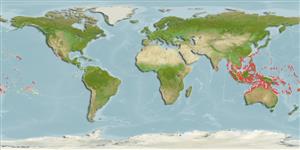>
Eupercaria/misc (Various families in series Eupercaria) >
Labridae (Wrasses) > Corinae
Etymology: Macropharyngodon: Greek, makros = great + Greek, pharyngx = pharynx + Greek,odous = teeth (Ref. 45335).
More on author: Herre.
Environment: milieu / climate zone / depth range / distribution range
Ekologi
laut berasosiasi dengan karang; nir-ruaya; kisaran kedalaman 8 - 32 m (Ref. 1602), usually 8 - 32 m (Ref. 27115). Tropical; 24°C - 28°C (Ref. 27115); 30°N - 24°S
Eastern Indian Ocean and Western Pacific: Andaman Sea (Ref. 9710) and Christmas Island (Ref. 30874) to the Philippines and Samoa, north to Ryukyu Islands, south to northern Australia.
Size / Weight / umur
Maturity: Lm ? range ? - ? cm
Max length : 12.0 cm TL jantan/; (Ref. 9710)
Duri punggung (Keseluruhan (total)) : 9; duri punggung lunak (Keseluruhan (total)) : 11; Duri dubur: 3; Sirip dubur lunak: 11; vertebrata, bertulang belakang: 25. Color in life of black with iridescent blue-green spots on body and light yellow antero-dorsally on head body; head banded. Anterior lateral line pored scales 2-3. Males display with metallic green shiny color that is turned on shortly for the occasion (Ref. 48636).
Inhabits lagoon and seaward reefs, in areas of mixed sand and coral (Ref. 9710). Post pelagic juveniles carried by currents beyond their normal breeding range. They are often in pairs or small loose groups, swimming close to the bottom. When approached, they move up and down in an unusual way that may worry a possible predator. Adults move about in small groups. (Ref. 48636).
Life cycle and mating behavior
Maturities | Reproduksi, perkembang biakan | Spawnings | Egg(s) | Fecundities | Larva
Oviparous, distinct pairing during breeding (Ref. 205).
Randall, J.E., 1978. A revision of the Indo-Pacific labrid fish genus Macropharyngodon, with descriptions of five new species. Bull. Mar. Sci. 28(4):742-770. (Ref. 2694)
Status IUCN Red List (Ref. 130435)
ancaman kepada manusia
Harmless
penggunaan manusia
Perikanan: komersial; Akuarium: Komersial
Alat, peralatan
laporan khas
muat turun XML
Sumber internet
Estimates based on models
Preferred temperature (Ref.
123201): 25.2 - 29, mean 28.1 °C (based on 866 cells).
Phylogenetic diversity index (Ref.
82804): PD
50 = 0.5002 [Uniqueness, from 0.5 = low to 2.0 = high].
Bayesian length-weight: a=0.00977 (0.00470 - 0.02030), b=3.07 (2.89 - 3.25), in cm total length, based on LWR estimates for this (Sub)family-body shape (Ref.
93245).
Trophic level (Ref.
69278): 3.5 ±0.4 se; based on size and trophs of closest relatives
Daya lenting (Ref.
120179): Tinggi, Waktu penggandaan populasi minimum kurang dari 15 bulan (Preliminary K or Fecundity.).
Fishing Vulnerability (Ref.
59153): Low vulnerability (10 of 100).
Nutrients (Ref.
124155): Calcium = 99.8 [59.3, 177.4] mg/100g; Iron = 0.773 [0.445, 1.445] mg/100g; Protein = 18.5 [15.6, 20.7] %; Omega3 = 0.17 [0.11, 0.28] g/100g; Selenium = 22.8 [13.0, 42.4] μg/100g; VitaminA = 158 [48, 611] μg/100g; Zinc = 1.75 [1.17, 2.72] mg/100g (wet weight);
